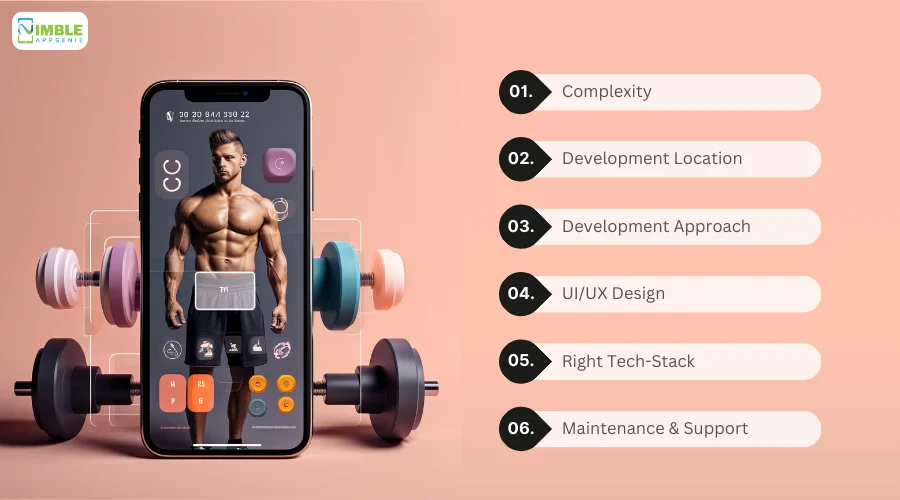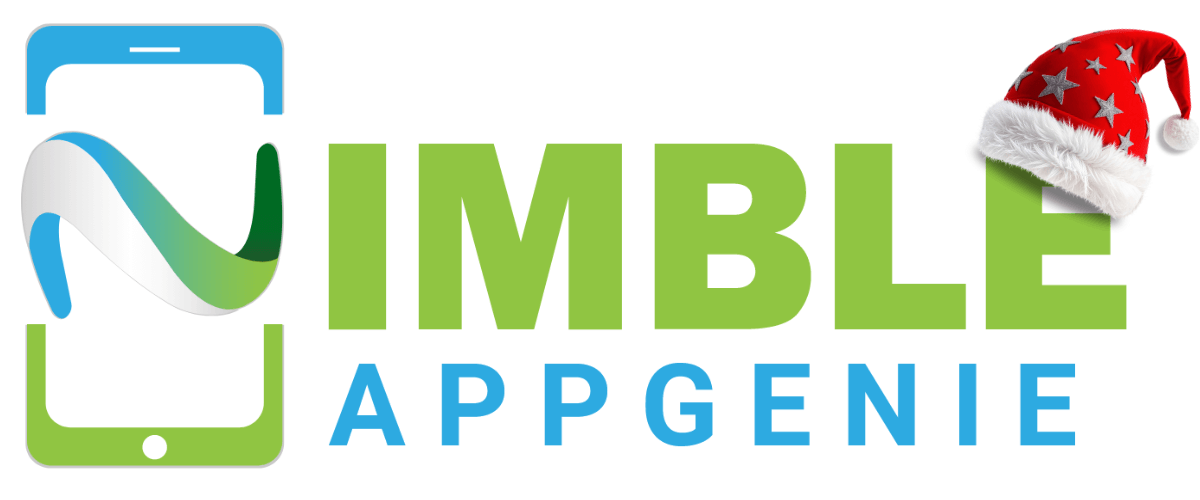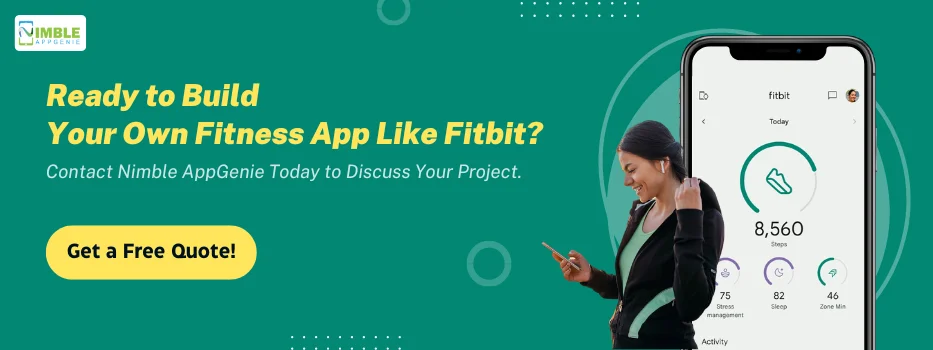The Fitness App Market is booming!
Numerous top-notch apps like Fitbit are making our lives easier and healthier than ever before.
From monitoring our health vitals to providing tailored recommendations, they have become our constant companions, helping us stay physically and mentally fit.
These apps empower us to take charge of our well-being and live healthier lives, which is a need in current times.
The exploding popularity of fitness apps isn’t just attracting users; it’s also got investors keeping a keen eye on the market, eager to enter with a solution into this lucrative market.
Fitbit is an inspiration for many. And, if it is for you as well, then we are sure that the first question you have in your mind is “How much does it cost to develop an app like Fitbit?”
The cost to develop an app like Fitbit ranges from $20,000 to $150,000. However, there are several factors, such as features, development team location, and expertise, that contribute to the final price. So, this price can vary as per your project requirements.
We will discuss all of this in this blog.
Market Stats of Fitness Apps
Market stats tell us a lot about the current state and future of any industry. So let’s take a look at some fitness stats that reveal a lot about the fitness app landscape.
The fitness tracker market was valued at 73.29 billion in 2025, and it is expected to increase by $323.63 billion in 2035 at a CAGR of 16%.
![]()
Although there are regions where fitness apps have tremendous popularity, North America is leading the way by contributing 39% of the growth in the global fitness tracker market during the forecast period.
Talking about only Fitbit, the user base continues to flourish, reaching an impressive 128 million users in 2023. Also, the app generated a staggering $1.04 billion in revenue in 2023. And, still, the numbers are rising.
With such astounding revenue, we can see why businesses are so keen to hire mobile app developers to build such apps.
Cost to Develop an App Like Fitbit
So, how much does it cost to create a Fitness App like Fitbit?
As discussed, the cost to develop an app like Fitbit typically ranges from $20,000 to $150,000.
Several factors that drive the cost can vary the final price. We are sharing a quick breakdown of the cost to make a fitness app for your understanding:
| Basis | Estimated Cost |
| Basic activity tracking | $5,000-$10,000 |
| Sleep tracking | $5,000-$10,000 |
| Workout routines & logging | $7,000-$12,000 |
| Calorie tracking & meal planning | $10,000-$15,000 |
| Simple social features | $5,000-$10,000 |
| Data Visualization | $3,000-$7,000 |
| Offline functionality | $5,000-$8,000 |
| Basic Wearable Integration | $3,000-$7,000 |
Note: This is just an estimate, but if you want to know the exact cost to develop a Fitness app like Fitbit, you should consult with a mobile app development company. Moving forward, let’s get to know the cost part in detail.
Factors Affecting the Cost to Develop a Fitness App Like Fitbit
While several factors influence the final cost, let’s explore how they specifically impact the budget to make a fitness app like Fitbit.
Let’s get to them:

-
Complexity
Among all the other factors, did you know that complexity is the most common factor that affects Fitbit-like app development cost?
If you go for core functionalities such as activity logging, sleep monitoring, or step tracking, then your cost will be less compared to implementing advanced features such as personalized workout plans, advanced sleep analysis, and more.
-
Development Location
The development location also plays an important role in affecting the cost to launch an app like Fitbit.
For example, if you hire developers from regions like North America or Western Europe, they will have a higher hourly rate as compared to regions like Europe or Southeast Asia.
This will be clearer with this quick breakdown of the hourly rates of different countries.
| Countries | Hourly rate |
| America | $120-$150 |
| Australia | $100-$120 |
| UK | $80-$100 |
| Eastern Europe | $50-$80 |
| Asia | $25-$80 |
-
Development Approach
Once you have an idea, it’s time to find an app developer.
There are many ways to do this, i.e., outsourcing, staff augmentation, hiring an in-house team, and outsourcing to an app development company.
Outsourcing vs. In-house has been a hot topic in the industry for a long time.
But, we advise you to go for outsourcing as they have experienced developers and professionals who have previously worked on similar projects. So, hiring a team with skills and experience will be cost-effective.
-
UI/UX Design
UI/UX design costs can vary depending on factors.
You see, a simple and functional design can be achieved within a limited budget.
However, collaborating with UI/UX design professionals to create a more polished user interface will surely increase the cost of making an app like Fitbit.
-
Right Tech-Stack
Choosing the tech stack is a responsible task that can affect the overall cost of developing an app like Fitbit.
Selecting a tech stack that can’t handle future growth or user load sets your app up for expensive headaches.
So, while evaluating project requirements and budget is a must, you should also emphasize choosing technology that can scale and adapt alongside your app’s success.
-
Maintenance & Support
In the list, the last factor we have is “Maintenance & Support”.
Updates are crucial to survive in the market, but this means they can increase overall cost. You should start working on the feedback from the start to keep your app more aligned with user needs & save yourself huge budget overruns in the future.
So, this is a factor that can increase the cost to make a Fitbit-like fitness app. Overlooking this might result in a bloated app that’s expensive to develop and maintain, yet fails to retain users.
Features That Can Determine Your App’s Success
Features are the backbone of any app. One of the top reasons Fitbit is so successful is its exceptional features.
Taking inspiration from Fitbit, here is a list of some features that are worthy of your attention.
![Features_That_Can_Determine_Your_App’s_Success[1]](https://www.nimbleappgenie.com/blogs/wp-content/uploads/2024/05/Features_That_Can_Determine_Your_Apps_Success1.webp)
1. Goal Setting & Tracking
You should have this feature to create an app like Fitbit where you allow your users to set their goals such as whether they want to do weight loss, muscle gain, and improved endurance.
This way, they can track their progress and clearly visualize their growth over time.
2. Customized Workout Plans
Fitbit provides tailored content, which means they don’t believe in a one-size-fits-all approach.
So, to create a fitness app, you can ensure that you offer AI-powered workout plans that adapt to fitness levels, goals, and preferences. By doing so, the effectiveness of your app will increase.
3. Seamless Wearable Integration
You can ensure syncing with popular wearable fitness technology and trackers. Display real-time data like heart rate, calories burned, and sleep patterns within an app for a holistic view of progress.
This way, you can provide personalized recommendations and help them track their progress.
4. High-Quality Video Workouts & On-Demand Classes
High-quality video workouts and on-demand classes are the need of the hour.
Many workout streaming apps like Peloton also leverage this to provide guided workouts. You can integrate this to build a fitness app like Fitbit that is led by certified trainers and caters to every level of a person.
You can offer on-demand classes for added variety and more flexibility.
5. Nutrition Tracking & Meal Planning
It’s a concept commonly found in nutrition and meal planning app development through which one can track their meals and keep them as per their fitness goal.
Doing so will make your app a one-stop solution for user needs.
Other than that, you can ask your users to scan barcodes, set daily goals, and access healthy recipe suggestions for a well-rounded approach.
6. Gamification
Another top feature for your fitness app that is quite prevalent is “Gamification,” which will surely keep your users engaged with your app. Also, you can keep users engaged with a fun and rewarding experience.
You can implement points, badges, and leaderboards for friendly competition within the community. It’s currently a rising fitness trend, so we’d suggest you leverage this.
7. Advanced Data Functionality
With the help of such functionality, users can get better insights about their workouts and understand areas for improvement.
If you use AI for that, it will be even better. They can offer personalized recommendations based on these predictions. AI can analyze their sleep patterns, identify workout trends, and then predict future trends or potential risks.
8. Offline Functionality
Offline functionality is one such feature that offers offline functionality to everyone.
With this feature, users can continue their workout routine even when there is less internet coverage. It caters to users who prefer outdoor workouts. This way, one can access workout routines, tracking features, and music playlists without an internet connection.
Once we are done with this, let’s move forward to understand the cost of developing an app like Fitbit.
Monetization Models for Your Fitbit-Like App
Why should investors look forward to investing in mobile app development? To make money, right? So, to enjoy revenue, we are sharing some amazing app monetization strategies for your app.
Fitbit-like app focuses on health and fitness; you can consider the models below for your Fitbit-like app development.
![Monetization_Models_for_Your_Fitbit-Like_App[1]](https://www.nimbleappgenie.com/blogs/wp-content/uploads/2024/05/Monetization_Models_for_Your_Fitbit-Like_App1.webp)
► Freemium Model
This is a popular choice among investors; it offers a free basic version with core functionalities like step tracking, sleep monitoring, and workout routines, and then once users see the amazing features that you can offer.
If you want advanced features like personalized workout plans, detailed sleep analysis, nutrition guidance, or access to exclusive challenges, you can upgrade to Premium. It’s also gaining momentum in different models, such as yoga app development, etc.
► Subscription Model
This provides a recurring revenue stream. You can offer tiered subscriptions with different pricing based on features that users pay for monthly, quarterly, or yearly.
Subscription-based apps are increasing day by day, so it’s a proven way. But to leverage this, you should also provide your users with exclusive content that makes it worth it to pay for your features.
► In-App Purchase
In-app purchases are a great app monetization model for your app, through which you can ensure that your users get to choose what they want to pay for. This includes workout programs, targeted meal plans, unique data visualizations, and more.
► Sponsorship
Partner with other fitness companies or third-party providers for in-app promotions or sponsored challenges. This way, your app’s popularity will increase and will also open an additional stream of revenue.
So, these are some ways through which you can generate revenue. Now, if you are looking for a top app development company to be your partner, see the next section.
How Can Nimble AppGenie Build an App Like Fitbit?
If you are inspired by Fitbit and want to make an app like Fitbit, be sure to partner with a company that has experience in the health and fitness app space.
For that, Nimble AppGenie is the perfect Fitness App Development Company to partner with and launch a cutting-edge fitness app.
We have worked on similar projects, and our developers excel in making feature-rich and innovative apps that keep users engaged and motivated.
Contact us to hire dedicated developers for your project.
Conclusion
The fitness app market is booming, and there’s a lot to consider when developing your own.
Understanding the features that make a Fitbit-like app successful and the factors affecting development costs are crucial.
By carefully choosing development partners, features, and monetization models, you can create an engaging and profitable fitness app that stands out in a crowded market.
FAQs
Several features contribute to a fitness app’s success, including:
- Goal setting and tracking
- Personalized workout plans
- Seamless wearable integration
- High-quality video workouts and on-demand classes
- Nutrition tracking and meal planning
- Gamification elements
- Advanced data functionality with insights
- Offline functionality
The cost to develop an app like Fitbit ranges from $20,000 to $150,000, depending on factors like features, development team location, and complexity.
Here are some key factors affecting development costs:
- Complexity of features
- Development team location (hourly rates)
- Development approach (in-house vs outsourcing)
- UI/UX design quality
- Tech stack chosen for scalability
- Ongoing maintenance and support
Popular monetization models for fitness apps include:
- Freemium model with a free basic version and premium features for a fee
- Subscription model with tiered pricing for access to exclusive content
- In-app purchases for specific workout programs or data visualizations
- Sponsorships and partnerships with fitness brands or health providers
Look for experienced app development companies with a proven track record in the health and fitness industry. Nimble AppGenie is one such company that provides the expertise and resources to create an engaging and successful app.

Niketan Sharma, CTO, Nimble AppGenie, is a tech enthusiast with more than a decade of experience in delivering high-value solutions that allow a brand to penetrate the market easily. With a strong hold on mobile app development, he is actively working to help businesses identify the potential of digital transformation by sharing insightful statistics, guides & blogs.
Table of Contents






No Comments
Comments are closed.